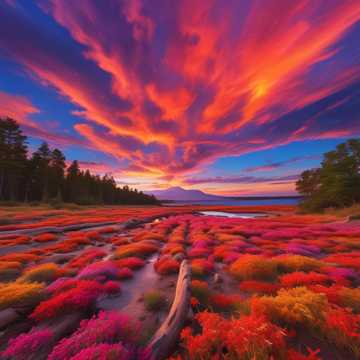On August 27, 1883, the world witnessed one of the most spectacular natural events in recorded history. The eruption of Krakatoa, a volcanic island in Indonesia, not only reshaped the local landscape but also painted the global sky in a palette of vibrant colors that would inspire artists for years to come.
The Day the Earth Shook
Krakatoa’s eruption was a cataclysmic event that reshaped our understanding of volcanic power.
Key Facts
- Location: Between Java and Sumatra, Indonesia
- Date: August 27, 1883
- Eruption Force: Equivalent to 200 megatons of TNT
- Sound: Heard up to 3,000 miles away
A Global Spectacle Unfolds
While the immediate impact was devastating, the aftermath created a worldwide natural light show.
The Colorful Aftermath
- Ash and gases were propelled high into the atmosphere
- Particles scattered sunlight, creating vivid red and orange skies
- Spectacular sunsets were observed globally for months
Artistic Inspiration
The eruption’s atmospheric effects captivated artists around the world.
Notable Artworks
- Edvard Munch’s “The Scream” is believed to be inspired by Krakatoa’s skies
- William Ascroft created hundreds of color sketches of the sunsets in Chelsea, London
Scientific Impact
Krakatoa’s eruption advanced our understanding of global weather patterns and volcanic activity.
Key Discoveries
- Global Cooling: Temporary drop in global temperatures
- Weather Patterns: Enhanced understanding of how volcanic eruptions affect climate
- Tsunami Formation: Improved knowledge of volcano-triggered tsunamis
Legacy: A Reminder of Nature’s Power and Beauty
The Krakatoa eruption of 1883 left a lasting impact on science, art, and our appreciation of nature’s forces.
Continuing Influence
- Inspiration for novels, films, and documentaries
- Ongoing volcanic activity in the region (Anak Krakatoa)
- Improved volcanic monitoring and tsunami warning systems
Conclusion: When Nature Paints the Sky
The Krakatoa eruption of 1883 reminds us of the raw power of nature and its capacity to create beauty from destruction. It stands as a testament to the interconnectedness of our world and the far-reaching impacts of natural events.
Have you ever witnessed an extraordinary natural phenomenon? Share this article and tell us about your experience with nature’s wonders!


